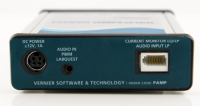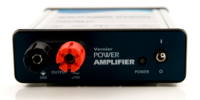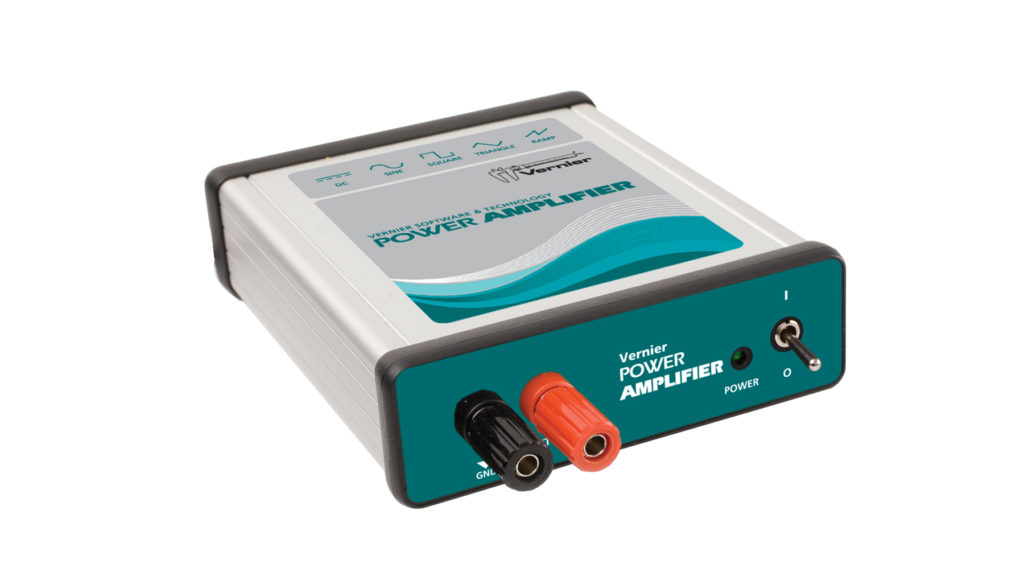Power Amplifier User Manual
Order Code: PAMP
With the Vernier Power Amplifier, you can drive loads with ±10 V and currents up to 1 A. It works with any input waveform, including DC, sine, square, triangle, and sawtooth waveforms. The Power Amplifier can drive a variety of loads, such as speakers, lamps, small DC motors, and RLC circuits. These circuits typically draw more power than the signal source can deliver. The Power Amplifier makes it possible to drive these heavy loads.
- This sensor works with LabQuest® and with most function generators.
- It can provide a steady, linearly controlled DC output for driving loads like DC motors, and precise AC waveforms for driving things like speakers
- Current is limited to protect against overload and shorting.
- The current monitor function enables you to log real-time load current.
- The class A-B Push-Pull Amplifier provides low distortion.
Note: Vernier products are designed for educational use. Our products are not designed nor are they recommended for any industrial, medical, or commercial process such as life support, patient diagnosis, control of a manufacturing process, or industrial testing of any kind.
What's Included
- Power Amplifier
- Power Supply
- 3.5 mm audio cable for LabQuest control
- BTA cable for LabPro input and current sensing

Compatible Software
Choose a platform below to see its compatibility requirements.
LabQuest
| Interface | LabQuest App |
|---|---|
| LabQuest 3 | Full support |
| LabQuest 2 | Full support |
| LabQuest | Full support |
Computers
| Software | ||||
|---|---|---|---|---|
| Interface | Graphical Analysis | Graphical Analysis (Web App) | Logger Pro (discontinued) | Logger Lite (discontinued) |
| LabQuest Mini | Full support 1 | Full support 1 | Full support 1 | Full support 1 |
| LabQuest 3 | Full support 1 | Full support 1 | Full support 1 | Incompatible 1 |
| LabQuest 2 | Full support 1 | Full support 1 | Full support 1 | Full support 1 |
| LabQuest Stream | Full support 1 2 | Full support 1 2 | Full support 1 | Full support 1 2 |
| Go!Link | Full support 1 | Full support 1 | Full support 1 | Full support 1 |
| LabQuest | Full support 1 | Full support 1 | Full support 1 | Full support 1 |
| LabPro | Incompatible | Incompatible | Full support 1 | Full support 1 |
Compatibility Notes
- Requires an additional signal source, such as LabQuest running the Power Amplifier app or a computer running the Power Amplifier Function Generator Software, to control the Power Amplifier output
- Connect LabQuest Stream via USB. Wireless connection is not supported.
Chromebook
| Software | |
|---|---|
| Interface | Graphical Analysis (Web App) |
| LabQuest Mini | Full support 1 |
| LabQuest 3 | Full support 1 |
| LabQuest 2 | Full support 1 |
| LabQuest Stream | Full support 1 2 |
| Go!Link | Full support 1 |
| LabQuest | Full support 1 |
Compatibility Notes
- Requires an additional signal source, such as LabQuest running the Power Amplifier app or a computer running the Power Amplifier Function Generator Software, to control the Power Amplifier output
- Connect LabQuest Stream via USB. Wireless connection is not supported.
iOS
| Software | ||
|---|---|---|
| Interface | Graphical Analysis | Graphical Analysis GW |
| LabQuest Stream | Full support 1 | Full support 1 |
| LabQuest 3 | Full support 2 | Full support 2 |
| LabQuest 2 | Full support 2 | Full support 2 |
Compatibility Notes
- Requires an additional signal source, such as LabQuest running the Power Amplifier app or a computer running the Power Amplifier Function Generator Software, to control the Power Amplifier output
- iOS and Android™ devices can only connect to LabQuest 2 or LabQuest 3 via Wireless Data Sharing.
Android
| Software | ||
|---|---|---|
| Interface | Graphical Analysis | Graphical Analysis GW |
| LabQuest Stream | Full support 1 | Full support 1 |
| LabQuest 3 | Full support 2 | Full support 2 |
| LabQuest 2 | Full support 2 | Full support 2 |
Compatibility Notes
- Requires an additional signal source, such as LabQuest running the Power Amplifier app or a computer running the Power Amplifier Function Generator Software, to control the Power Amplifier output
- iOS and Android™ devices can only connect to LabQuest 2 or LabQuest 3 via Wireless Data Sharing.
LabVIEW
| Software | |
|---|---|
| Interface | NI LabVIEW |
| SensorDAQ | Full support 1 |
| LabQuest Mini | Full support 1 |
| LabQuest Stream | Full support 1 |
| LabQuest 3 | Full support 1 |
| LabQuest 2 | Full support 1 |
| LabQuest | Full support 1 |
Compatibility Notes
- Requires an additional signal source, such as LabQuest running the Power Amplifier app or a computer running the Power Amplifier Function Generator Software, to control the Power Amplifier output
Texas Instruments
| Software | |||||
|---|---|---|---|---|---|
| Interface | EasyData | DataMate | TI-84 SmartView | DataQuest | TI-Nspire Software |
| EasyLink | Full support 1 2 | Incompatible | Full support 2 3 | Full support 2 | Full support 2 3 |
| CBL 2 | Full support 2 4 | Full support 2 4 5 | Incompatible | Incompatible | Incompatible |
| LabPro | Full support 2 4 | Full support 2 4 5 | Incompatible | Incompatible | Incompatible |
| TI-Nspire Lab Cradle | Incompatible | Incompatible | Incompatible | Full support 2 | Full support 2 |
Compatibility Notes
- Use with TI-84 Plus calculators only.
- Requires an additional signal source, such as LabQuest running the Power Amplifier app or a computer running the Power Amplifier Function Generator Software, to control the Power Amplifier output
- Requires an Easy to Go! adapter
- CBL 2 and LabPro interfaces cannot be used with TI-84 Plus CE calculators.
- DataMate cannot be used with color screen TI-84 Plus calculators; use EasyData with these calculators.
Getting Started
Some circuits require more current than can be delivered by the output of a Vernier LabQuest or other signal sources. The Vernier Power Amplifier amplifies an existing signal so that it can be used to drive a speaker, a coil, an RLC circuit, a motor, a resistor for heating experiments, electrolysis apparatus or other experimental apparatus. A list of suggested activities can be found at www.vernier.com/til/15021.
When designing an experiment using the Power Amplifier, consider the following:
- Input Signal - The Power Amplifier requires an input signal source to function; it does not create any waveforms without input. Most commonly it is used with a LabQuest or with any AC or DC signal source that does not exceed 12 V, such as the Function Generator (FGEN-PAMP). The Power Amplifier provides both current and voltage gain so that larger loads can be driven than is possible with the signal source alone.
- Output - The output of the Power Amplifier can be connected to a speaker, a test circuit such as an RLC circuit, or any device that requires a controlled AC or DC signal.
- Current Sensor - The current sense port allows monitoring of the current through the output stage of the Power Amplifier. Connect this to a LabQuest or other Vernier interface.
Using the Product
Connections on the Power Amplifirer
The Power Amplifier has several connectors used to control and monitor the output.
- 3.5 mm Audio Port - The primary input is the 3.5 mm audio-style port on the back panel.
- BTA Port - The secondary input is the BTA receptacle on the back panel that serves as both an input from LabPro and as a current sense output.
- Red/Black Output Terminals - The two output terminals on the front panel are used to connect the load circuit. The negative (black) terminal is connected to ground via a 0.1 Ω resistor. The red terminal can range between ±10V.

|

|
|
The back of the Power Amplifier, showing the Power Connector, the Audio/LabQuest Connector, and the BTA Connector |
The front of the Power Amplifier, showing the output terminals, the Power Indicator LED, and the On/Off Switch |
Choosing an Input Signal for the Power Amplifier
The most common input signals for the Power Amplifier are a LabQuest or a function generator. Other signal inputs to the Power Amplifier, including using a LabPro, are described at www.vernier.com/til/15045.
Use Power Amplifier with LabQuest App

Power Amplifier connected to a LabQuest audio out connector
The Power Amplifier requires a LabQuest 3, LabQuest 2, or original LabQuest with LabQuest App 1.2 or newer. (LabQuest App 1.3 or newer is recommended.) Launch the LabQuest Power Amplifier App by selecting it in the home menu. If it is not present in the home menu, see www.vernier.com/labquest/updates/ for information on updating your original LabQuest.
The Power Amplifier App includes waveform options of sine, triangle, square wave, ramp up, and ramp down and DC. For the sine, square wave, ramp, and triangle waveforms, you can set the frequency with the keyboard, the up and down arrow keys, and the slider. The slider provides an easy way to change the frequency: tap to the right or left of the slider control to double the current setting, or drag the control to change the frequency smoothly. The VDC control is only used for the DC waveform.
The Power Amplifier App can be run simultaneously with LabQuest App. For example, the current sense output of the Power Amplifier is used with the LabQuest App, while the control of the Power Amplifier is retained by the Power Amplifier App. To switch between them, choose each by name in the LabQuest home menu. This way you can control the output of the Power Amplifier while simultaneously recording the current in LabQuest App.
Use Power Amplifier with Function Generator
The Vernier Power Amplifier can be used with most function generators. Connect the function generator to the 3.5 mm input using a mono connector only. A stereo connector may enable the PWM features of the Power Amplifier with undesirable results. When used with this input, the Power Amplifier applies a factor of ten gain to the input signal. The input is DC-coupled.

Connecting a function generator to the Power Amplifier with a mono audio cord
The Vernier Power Amplifier can be used with most function generators. Connect the function generator to the 3.5 mm input using a mono audio connector only. The Function Generator (order code FGEN-PAMP) comes with a BNC-mono cable designed for use with the Power Amplifier.
Use the function generator’s controls to select the waveform and frequency you wish to use in your experiment. When used with this input, the Power Amplifier applies a factor of ten gain to the input signal. The input is DC-coupled.
Videos
Specifications
LabQuest Audio (3.5 mm connector) Input
- DC coupled between tip and sleeve of 3‑conductor connector
- Frequency range DC to 15 kHz.
- Overall gain 10X
- Input impedance 10 kΩ.
BTA Analog Input
- DC coupled and has a total gain of 2X to the output.
- Input impedance is 50 kΩ.
- Maximum input ±12V without damage.
- This input is on pin 1, or the yellow wire, of the BTA Cable (see www.vernier.com/til/5457 for details)
BTA Current Sensing
- There is a 0.1 Ω resistor between the black terminal and ground. Current measurements are based on the voltage drop across this resistor.
How the Sensor Works
The Vernier Power Amplifier is a DC-coupled amplifier capable of delivering 1 A at 10 V. In many applications, the amplifier will simply increase the amplitude of the input signal. This is true for audio-frequency applications.
In other applications a much lower frequency output is desired. Since many audio sources are not DC-coupled, the Power Amplifier includes a novel pulse-width- modulated (PWM) input to create extremely low-frequency waveforms and DC offsets. The output of the PWM section is added to the input of the amplifier. For example, an experiment might demand a signal of a few hertz. A typical signal generator cannot create an output at that frequency, but the Power Amplifier can generate such a waveform when driven with the correct PWM signal.
Finally, a current-sensing resistor allows monitoring of the output current. This signal is available at the current-sense output connector. When this output is connected to an analog input of a LabQuest or LabPro, a calibrated, autoID current sensor is detected by software.
Input DC Blocking
Some signal sources contain an undesirable DC offset. Since the Power Amplifier is DC-coupled in order to produce DC signals, any offset will be amplified alongside an AC waveform. To block unwanted DC signals, add a 1 µF non‑polarized capacitor in series to the input.
Output Circuit
The Vernier Power Amplifier has an analog Class A/B push pull output section that will drive currents up to 1 A at frequencies from DC to over 10 kHz. It has a soft current limit, intended as a safety net. Do not connect the Power Amplifier to a load that would require more than 1 A. Load current can be calculated by dividing the output voltage by the resistance of the load or dividing the wattage of the load by the operating voltage.
The output is bipolar but not differential or balanced. In other words, the black terminal is at approximately zero volts and the red swings positive and negative. A current sense resistor of 0.1 Ω is between the black terminal and true ground.
Grounding Concerns
The Power Amplifier is not grounded through the external power connections, so any external voltage source applied to the black terminal will find its way back to ground through the LabQuest or LabPro. This is not of any concern when driving floating loads (a load with only two leads and each connected ONLY to the Power Amplifier terminals.)
Despite the ungrounded output, take care when driving any load that is part of another electrical system, such as a robotic device or computer peripheral. If you have any doubts about ground loops, connect the black Power Amplifier terminal to your system ground. The Power Amplifier current sensor may give false readings with two ground paths but this connection method reduces the chances of any damage to your LabQuest or LabPro. Running the LabQuest on battery power (and not connected to a computer host) also reduces the chance of ground currents returning through the LabQuest. Any time your LabQuest or LabPro unit is connected to a computer with a USB cable it is connected to that computer’s ground which, in turn, is probably grounded to the building’s power system ground through the AC plug.
Stability
The Power Amplifier output section uses distributed feedback to achieve accuracy and DC stability. The feedback circuits have been designed to be stable with a wide range of loads but highly reactive loads with very low resistance may present a high enough Q to incite oscillation. When driving reactive loads you should always have at least a few ohms in series. This is also good protection against an over-current condition.
Current Sensor Output
The Power Amplifier contains a current sensor that can be read by a LabQuest, LabPro, SensorDAQ, or Go!Link. Connect the supplied BTA cable between the Power Amplifier and the interface. When the Power Amplifier is turned on, the current sensor will be detected by the data-collection software. The bandwidth of the current sensor is not as high as the amplifier since it is a trade-off between noise and several other factors.
For the current sensor to read correctly, all of the current that passes through the load must return through the black terminal. For this reason, loads that have a ground connection will not allow reliable current measurements. In particular, do not use a simple 10 V Voltage Probe (order code VP-BTA) with the Current Sensor, because the Voltage Probe will ground part of the circuit. Instead, use a Differential Voltage Probe (order code DVP-BTA).
Troubleshooting
For troubleshooting and FAQs, see www.vernier.com/til/1986
Accessories/Replacements
| Item | Order Code |
|---|---|
|
FGEN-PAMP |
|
|
PAAS-PAMP |
Repair Information
If you have watched the related product video(s), followed the troubleshooting steps, and are still having trouble with your Power Amplifier , contact Vernier Technical Support at support@vernier.com or call 888-837-6437. Support specialists will work with you to determine if the unit needs to be sent in for repair. At that time, a Return Merchandise Authorization (RMA) number will be issued and instructions will be communicated on how to return the unit for repair.
Warranty
Warranty information for this product can be found on the Support tab at www.vernier.com/pamp/#support
General warranty information can be found at www.vernier.com/warranty
Disposal
When disposing of this electronic product, do not treat it as household waste. Its disposal is subject to regulations that vary by country and region. This item should be given to an applicable collection point for the recycling of electrical and electronic equipment. By ensuring that this product is disposed of correctly, you help prevent potential negative consequences on human health or on the environment. The recycling of materials will help to conserve natural resources. For more detailed information about recycling this product, contact your local city office or your disposal service.
Battery recycling information is available at www.call2recycle.org
Do not puncture or expose the battery to excessive heat or flame.
Contact Support
Fill out our online support form or call us toll-free at 1-888-837-6437.

